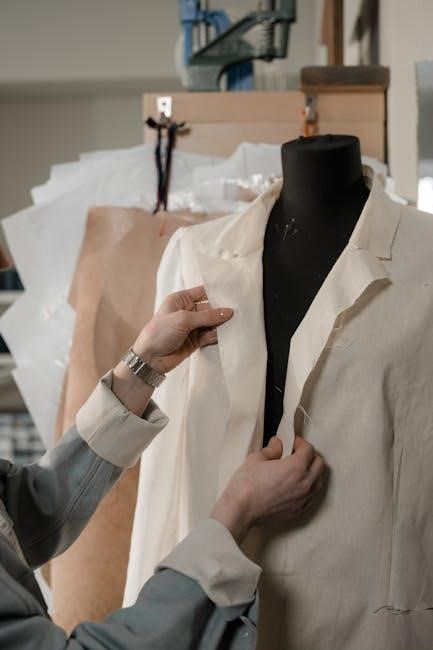Welcome to the jacket measurement guide, your key to finding the perfect fit. This guide helps you understand measurements, size charts, and styles, ensuring a flattering and comfortable jacket choice.
Importance of Proper Fit
A proper fit is essential for both comfort and style when it comes to jackets. A well-fitting jacket ensures optimal mobility and a flattering appearance, avoiding the discomfort of being too tight or the bulkiness of being too loose. Whether for casual wear or formal occasions, the right fit enhances your confidence and overall look. Improper sizing can lead to restricted movement or an unflattering silhouette, making it crucial to prioritize accurate measurements. By understanding your body measurements and comparing them to size charts, you can select a jacket that aligns with your needs. Proper fit also ensures functionality, especially for outerwear designed for specific activities like sports or formal events. Investing time in measuring and selecting the right size guarantees a jacket that feels great and looks even better. A perfect fit is the cornerstone of a wardrobe staple, making it worthwhile to get it just right.
Understanding Jacket Styles
Understanding jacket styles is crucial for selecting the right fit. Jackets come in various designs, such as bomber, denim, leather, blazer, and overcoat, each with unique fits and purposes. A bomber jacket offers a snug, sporty fit, while a denim jacket provides a casual, relaxed silhouette. Leather jackets are often fitted and sleek, whereas blazers are tailored for a formal look. Overcoats are designed to be loose-fitting and longer for layering. Each style has specific measurement requirements, so it’s essential to choose the appropriate guide for your jacket type. Consider your body type, lifestyle, and personal style when selecting a jacket. Proper fit varies across styles, ensuring comfort and functionality. By understanding the differences, you can make informed decisions and find a jacket that meets your needs perfectly. This knowledge enhances your shopping experience and ensures satisfaction with your purchase. Styles vary widely, so choose wisely to complement your wardrobe effectively.

How to Measure for a Jacket
Measuring for a jacket involves assessing chest, sleeve length, shoulder width, and body length. Use a tape measure to ensure accuracy and a proper fit for your desired style.
Chest Measurement
The chest measurement is crucial for determining your jacket size. To measure accurately, wrap a flexible tape measure around the fullest part of your chest, just under your armpits. Ensure the tape is snug but not tight, with your arms relaxed at your sides. Inhale slightly to expand your chest naturally. Record the measurement in inches or centimeters. This measurement corresponds directly to standard jacket size charts, helping you choose the right fit. For example, a chest measurement of 38 inches typically aligns with a medium size in most brands. Always refer to the specific size chart provided by the manufacturer, as variations can occur between brands and styles. An accurate chest measurement ensures comfort and a flattering silhouette in your jacket.
Sleeve Length Measurement
Sleeve length measurement is essential for a well-fitted jacket. To measure accurately, start at the center back of your neck, just below the base, and run the tape measure over your shoulder, down to your wrist. Keep your arm relaxed at your side with your palm facing your thigh. Ensure the tape is straight and not twisted for an accurate reading. The measurement should reflect the length from the back of the neck to the wrist bone. This ensures the sleeves will neither be too short nor too long. For instance, a 24-inch sleeve length typically corresponds to a small size in most jackets. Always compare your measurement to the jacket size chart for the best fit. Accurate sleeve length ensures comfort and a polished appearance, making it a critical part of your jacket measurement process.
Shoulder Measurement
Accurate shoulder measurement is crucial for a jacket to sit properly on your frame. To measure your shoulders, place the tape measure at the tip of one shoulder, running it across your back to the tip of the other shoulder. Ensure the tape is level and follows the natural curve of your body. This measurement reflects the width of your upper body, which is essential for ensuring the jacket’s shoulders align perfectly with yours. For example, a shoulder measurement of 17-18 inches typically corresponds to a medium size in most jackets. This measurement, combined with chest and sleeve length, provides a comprehensive fit profile. Always refer to the jacket’s size chart to match your shoulder measurement for optimal comfort and style. Proper shoulder fit prevents the jacket from feeling too tight or slipping off, making it a vital part of the measurement process.
Body Length Measurement
Measuring your body length is essential for ensuring your jacket fits comfortably and suits your style. To determine your body length, stand upright and place the measuring tape at the base of your neck, centered at the back. Extend the tape straight down to the point where you want the jacket to end, typically at the hipbone for casual styles or lower for coats. This measurement ensures the jacket hits your body at the most flattering and functional length. For example, a body length of 29-30 inches is common for medium sizes, while longer jackets may measure 32 inches or more. Proper body length ensures the jacket doesn’t feel too short or overly long, balancing comfort and aesthetics. Always consult the size chart for specific styles, as body length varies across jacket types and brands to cater to different looks and needs;
Size Charts and Conversion
Understanding size charts and conversions is crucial for selecting the right jacket fit. Jackets are sized differently across regions and brands, so comparing measurements is essential. US, EU, UK, and other international sizes often vary, with numeric and alphabetic labels (e.g., S, M, L, XL) corresponding to specific chest and body measurements. For instance, a US medium may equate to a European large, while Asian sizes may differ entirely. To avoid confusion, refer to the size chart provided by the retailer or brand, as they often include detailed chest, sleeve, and body length measurements. Some charts also cater to specific styles, such as slim-fit or oversized jackets. By aligning your measurements with the chart, you can ensure a precise fit, whether shopping domestically or internationally. Always double-check the conversions to make an informed purchase and enjoy a jacket that fits perfectly to your body type and preferences.

International Size Conversions
International size conversions are essential for ensuring the right fit when shopping across borders or brands. Jacket sizes vary significantly between regions, with the US, EU, UK, and other countries having distinct sizing standards. For example, a US medium might correspond to a European large, while Asian sizes may differ entirely. Numeric sizing (e.g., 38, 40) is commonly used in Europe, whereas alphabetic labels (S, M, L, XL) dominate in the US and UK. To navigate this, refer to size charts that often include chest measurements in inches or centimeters. For instance, a chest measurement of 38-40 inches might align with a US large, a UK medium, or a European 50. Understanding these conversions ensures a seamless shopping experience, whether purchasing domestically or internationally. Always compare your measurements to the chart to find the perfect fit, regardless of the region or brand.

Factors Affecting Jacket Fit
Several factors influence how a jacket fits, including body type, posture, and personal style preferences. Your chest size, shoulder width, and body length are critical measurements. Additionally, fabric type and thickness play a role, as heavier materials may require a slightly larger size for comfort. Padding or insulation in jackets can also affect fit, adding bulk that may necessitate sizing adjustments. Posture can alter how a jacket sits on the body, with slouching or an upright stance changing the perceived fit. Layering clothing underneath further impacts the fit, so consider how many layers you plan to wear. Finally, personal preference for a slim, regular, or loose fit dictates the ideal size. Understanding these factors ensures a jacket that not only measures correctly but also feels comfortable and looks flattering. Always consider these elements when selecting a jacket to achieve the best possible fit.

Common Mistakes to Avoid
When measuring for a jacket, avoid common mistakes to ensure accuracy. Not using a flexible tape measure can lead to incorrect readings. Forgetting to keep the tape snug but not tight may result in a poor fit. Measuring over bulky clothing instead of a thin layer can exaggerate chest and waist sizes. Neglecting to account for posture variations, such as slouching, can throw off shoulder and sleeve measurements. Relying solely on standard sizes without considering style differences, like slim-fit or relaxed cuts, can lead to discomfort. Ignoring international size conversions might cause mismatches when shopping across brands. Lastly, not referencing size charts specific to the brand or style can result in sizing errors. By avoiding these mistakes, you can ensure precise measurements and a jacket that fits perfectly, enhancing both comfort and appearance.

Tips for the Best Fit
Ensuring a perfect jacket fit starts with accurate measurements. Always use a flexible tape measure and keep it snug but not tight. Measure over a thin layer of clothing, like a T-shirt, to avoid adding bulk. For chest measurements, wrap the tape around the fullest part of your chest, just under the armpits. Sleeves should be measured from the center back of your neck to your wrist for the correct length. Consider your posture—stand up straight to get precise shoulder and body length measurements. If you’re between sizes, opt for the larger size for comfort. Double-check size charts specific to the brand or style, as sizing can vary. Finally, if unsure, compare your measurements to a jacket you already own and adjust accordingly. By following these tips, you’ll achieve a flattering, comfortable fit tailored to your body.
Resources for Further Assistance
If you’re still unsure about your jacket size, there are plenty of resources available to guide you. Many brands offer detailed size charts on their websites, which include measurements for chest, sleeve length, and body length. ASOS, for example, provides a comprehensive size guide for their jackets and coats, allowing you to input your measurements and find the perfect fit. Additionally, websites like Mountain Equipment offer a size guide tailored to their specific products, ensuring accuracy. You can also refer to general jacket size calculators found online, which use your measurements to determine your size. For international shoppers, many retailers provide conversion charts to help you understand your size in different regions. If you’re still uncertain, consider reaching out to customer support, as many brands offer personalized sizing assistance. Always double-check the size chart provided with your chosen product for the best results.
Finding the perfect jacket fit is a combination of accurate measurements, understanding jacket styles, and using reliable size charts. By measuring your chest, sleeve length, shoulder, and body length, you can ensure a flattering and comfortable fit. Referencing size charts specific to the brand and style of your jacket is crucial, as sizes can vary. International size conversions and detailed guides, such as those from ASOS or Mountain Equipment, can further assist in making the right choice. Remember, proper fit enhances both style and functionality, whether you’re selecting a leather jacket, blazer, or outerwear. Use the resources provided, double-check your measurements, and don’t hesitate to seek personalized assistance if needed. With patience and the right tools, you’ll confidently find a jacket that fits perfectly, ensuring a polished and comfortable look for years to come.

Final Thoughts
A well-fitting jacket is more than just clothing; it’s a statement of style and confidence. By mastering the jacket measurement guide, you’ll navigate the complexities of sizing with ease, ensuring every piece in your wardrobe flatters your frame. Whether you’re shopping for a sleek blazer, a durable leather jacket, or a cozy outerwear piece, precise measurements are key to avoiding costly returns and discomfort. Remember, sizing varies across brands and styles, so always refer to specific size charts and international conversions. Don’t underestimate the importance of shoulder, chest, and sleeve measurements—they make all the difference. With patience and practice, you’ll find jackets that not only fit perfectly but also enhance your personal style. Invest time in understanding your measurements, and you’ll enjoy a seamless, enjoyable shopping experience every time. A great jacket is just a measurement away!